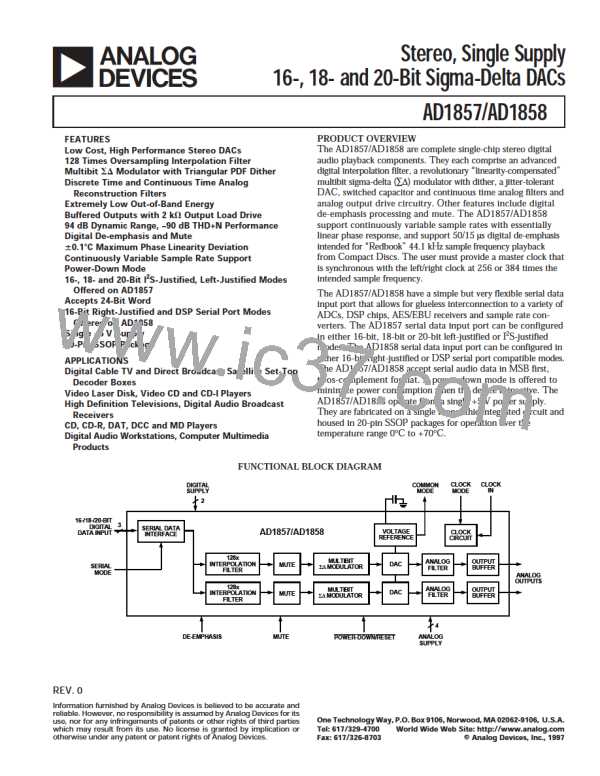AD1857/AD1858
TH EO RY O F O P ERATIO N
T he conventional problem limiting the performance of multibit
sigma-delta converters is the nonlinearity of the passive circuit
elements used to sum the quantization levels. Analog Devices has
developed (and received patents on) a revolutionary architecture
that overcomes the circuit element linearity problem that otherwise
limits the performance of multibit sigma-delta audio converters.
T his new architecture provides the AD1857/AD1858 with the
same excellent differential nonlinearity and linearity drift (over
temperature and time) specifications as single bit sigma-delta
DACs.
T he AD1857/AD1858 offer the advantages of sigma-delta con-
version architectures (no component trims, low cost CMOS
process technology, superb low-level linearity performance) with
the advantages of conventional multibit R-2R resistive ladder
audio DACs (continuously variable sample rate support, jitter
tolerance, very low output noise, etc.).
T he use of a multibit sigma-delta modulator means that the
AD1857/AD1858 generate dramatically lower amounts of out-
of-band noise energy, which greatly reduces the requirement on
post DAC filtering. T he required post-filtering is integrated on
the AD1857/AD1858. T he AD1857/AD1858’s multibit sigma-
delta modulator is also highly immune to digital substrate noise.
T he AD1857/AD1858’s multibit modulator has another
important advantage; it has a high immunity to substrate digital
noise. Substrate noise can be a significant problem in mixed-
signal designs, where it can produce intermodulation products
that fold down into the audio band. T he AD1857/AD1858 are
approximately eight times less sensitive to digital substrate noise
(voltage reference noise injection) than equivalent single-bit
sigma-delta modulator based DACs.
Ser ial Audio D ata Inter face
T he serial audio data interface uses the bit clock (BCLK) simply
to clock the data into the AD1857/AD1858. T he bit clock may
therefore be asynchronous to the L/R clock. T he left/right clock
(LRCLK) is both a framing signal and the sample frequency
input to the interpolation filter. T he left/right clock must be
synchronous with MCLK, but may have any phase relationship
with respect to MCLK; LRCLK is generally synchronously divided
down from MCLK. T he SDAT A input carries the serial stereo
digital audio in MSB first, twos-complement format.
D ither Gener ator
T he AD1857/AD1858 include an on-chip dither generator that
is intended to further “whiten” the quantization noise introduced
by the multibit DAC. T he dither has a triangular Probability
Distribution Function (PDF) characteristic, which is generally
considered to create the most favorable noise shaping of the
residual quantization noise. The AD1857/AD1858 are among the
first low cost IC audio DACs to include dithering.
D igital Inter polation Filter
T he purpose of the interpolator is to “oversample” the input
data, i.e., to increase the sample rate so the first signal image is
moved out to the oversample frequency, which relaxes the
attenuation requirements on the analog reconstruction filter.
T he AD1857/AD1858 interpolator increases the input data
sample rate by 128. T he interpolation is performed using a
multistage FIR digital filter structure. T he first stage is a droop
equalizer; the second and third stages are halfband filters; and
the fourth stage is a second-order comb filter. T he FIR filter
implementation is multiplier-free, i.e., the multiplies are performed
using shift-and-add operations. T he FIR filter coefficients have
been recoded in a canonical sign digit format to enable the use
of a compact arithmetic logic unit without a multiplier.
Analog Filter ing
The AD1857/AD1858 include a second-order switched
capacitor discrete time low-pass filter followed by a first-order
analog continuous time low-pass filter. T hese filters eliminate
the need for any additional off-chip external reconstruction
filtering. T his on-chip switched capacitor analog filtering is
essential to reduce the deleterious effects of master clock jitter.
D igital D e-Em phasis P r ocessing
The AD1857/AD1858 include digital circuitry for implementing
the 50/15 µs de-emphasis frequency response characteristic. A
control pin DEEMP (Pin 5) enables de-emphasis when it is
asserted HI. T he digital de-emphasis response assumes a sample
frequency of 44.1 kHz. T he transfer function magnitude error
of this digital filter is less than ±0.1 dB (from 0 kHz to 20 kHz)
compared to a 50/15 µs continuous time filter. If the sample
frequency is not 44.1 kHz, the de-emphasis frequency response
will scale directly with frequency. T he 44.1 kHz FS digital de-
emphasis frequency response is shown in Figure 8.
Multibit Sigm a-D elta Modulator
T he AD1857/AD1858 employ a 4-bit second-order sigma-delta
modulator. Whereas a traditional single-bit sigma-delta
modulator has two levels of quantization, the AD1857/AD1858’s
has 17 levels of quantization. T raditional single-bit sigma-delta
modulators sample the input signal at 64 times the input sample
rate; the AD1857/AD1858 sample the input signal at 128 times
the input sample rate. T he additional quantization levels
combined with the high oversampling ratio means that the
AD1857/AD1858 DAC output spectrum contains dramatically
lower levels of out-of-band noise energy, which is a major
stumbling block with more traditional single-bit sigma-delta
architectures. This means that the post-DAC analog reconstruction
filter has reduced transition band steepness and attenuation
requirements, which directly equates to lower phase distortion.
Since the analog filtering generally establishes the noise and
distortion characteristic of the DAC, the reduced requirements
translate into better audio performance.
T1 = 50µs
0
T2 = 15µs
–10
F2
F1
10.61
3.183
FREQUENCY – kHz
Multibit sigma-delta modulators bring an additional benefit:
they are essentially free of stability (and therefore potential loop
oscillation) problems. T hey are able to scale the output signal
to a wider range of the voltage reference, which can increase the
overall dynamic range of the converter.
Figure 8. Digital De-Em phasis Frequency Response
REV. 0
–9–

 ADI [ ADI ]
ADI [ ADI ]